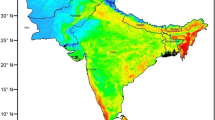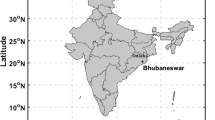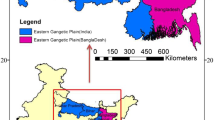Abstract
In the present work, the variability, trends and relationships of aerosol, cloud and rainfall are explored for three regions of the Indian subcontinent: the Indo-Gangetic Plain (IGP), central India (CI) and the North Indian Ocean (NIO). The investigated properties include the monthly averages of satellite retrievals for the aerosol optical depth (AOD), angstrom exponent (AE), aerosol index (AI), cloud effective radius (Re), cloud optical thickness (COT), cloud liquid water path (LWP) and rain rate (RR). Inter-annual and seasonal variability and long-term trends for these properties were analyzed over the regions selected. The analysis showed apparent regional and temporal variations in all seven parameters. Strong increases in aerosol properties over the IGP and CI regions over the last two decades have enabled the study of the response to cloud and rainfall properties. Further, aerosol–cloud–rain rate relationships during the summer monsoon were verified using linear fit analysis (using AOD [and AI], Re, LWP and RR) for the three regions, respectively. A negative relation between AOD and Re was seen over the three regions, whereas AOD and RR showed a negative relation over IGP and NIO. It was found that the AI property, which represents the aerosol number, is inversely correlated with Re but positively correlated with RR during the monsoon season over the IGP and CI. AI and LWP showed a negative relation for CI but a positive relation for IGP and NIO. We believe that this study will help in assessing regional and global climate impacts due to aerosols.




Similar content being viewed by others
References
Albrecht, B. A. (1989). Aerosols, cloud microphysics, and fractional cloudiness. Science, 245, 1227–1230.
Andreae, M. O., Rosenfeld, D., Artaxo, P., Costa, A. A., Frank, G. P., Longo, K. M., & Silva-Diass, M. A. F. (2004). Smoking rain clouds over the Amazon. Science, 303, 1337–1342.
Boucher, O., Randall, D., Artaxo, P., Bretherton, C., Feingold, G., Forster, P., Kerminen, V. M., Kondo, Y., Liao, H., Lohmann, U., Rasch, P., Satheesh, S. K., Sherwood, S., Stevens, B., & Zhang, X. Y. (2013). Clouds and aerosols. In T. F. Stocker, D. Qin, G.-K. Plattner, M. Tignor, S. K. Allen, J. Boschung, A. Nauels, Y. Xia, V. Bex, & P. M. Midgley (Eds.), Climate change 2013. The physical science basis. Contribution of Working Group I to the Fifth Assessment Report of the Intergovernmental Panel on Climate Change. Cambridge: Cambridge University Press.
Dey, S., Tripathi, S. N., Singh, R. P., & Holben, B. N. (2004). Influence of dust stroms on aerosol optical properties over the Indo-Gangetic basin. Journal of Geophysical Research. https://doi.org/10.1029/2004JD004924
Forster, P., Ramaswamy, V., Artaxo, P., Berntsen, T., Betts, R., Fahey, D., Haywood, J., Lean, J., Lowe, D., Myhre, G., Nganga, J., Prinn, R., Raga, G., Schulz, M., & Van Dorland, R. (2007). Climate change 2007. The physical science basis. Contribution of Working Group I to the Fourth Assessment Report of the Intergovernmental Panel on Climate Change, chap. Changes in atmospheric constituents and in radiative forcing (pp. 129–243). Cambridge: Cambridge University Press.
Gopal, R. K., Raja Obul Reddy, K., Balakrishnaiah, G., Arafath, S. M. D., Siva Kumar Reddy, N., Chakradhar Rao, T., Lokeswara Reddy, T., & Ramakrishna Reddy, R. (2016). Regional trends of aerosol optical depth and their impact on cloud properties over Southern India using MODIS data. Journal of Atmospheric and Solar Terrestrial Physics, 146, 38–48.
Gupta, P., Khan, M. N., da Silva, A., & Patadia, F. (2013). MODIS aerosol optical depth observations over urban areas in Pakistan: Quantity and quality of the data for air quality monitoring. Atmospheric Pollution Research, 4, 43–52.
Haywood, J., & Boucher, O. (2000). Estimates of the direct and indirect radiative forcing due to tropospheric aerosols. A review. Review of Geophysics, 38, 513–543.
Hazra, A., Taraphdar, S., Halder, M., Pokhrel, S., Chaudhari, H. S., Salunke, K., & Mukhopadhyay, P. (2013). Indian summer monsoon drought 2009: Role of aerosol and cloud microphysics. Atmospheric Science Letters, 14, 181–186.
Ichoku, C., Chu, D. A., Mattoo, S., Kaufman, Y. J., Remer, L. A., Tanre, D., Slutsker, I., & Holben, B. N. (2002). A spatio-temporal approach for global validation and analysis of MODIS aerosol products. Geophysical Research Letters, 29(12), Art. No. 1616.
Johnson, G., Ristovski, Z., & Morawska, L. (2004). Application of the VH-TDMA technique to coastal ambient aerosols. Geophysical Research Letters, 31, L16105. https://doi.org/10.1029/2004GL020126
Jones, T. A., & Christopher, S. A. (2010). Statistical properties of aerosol–cloud–precipitation interactions in South America. Atmospheric Chemistry and Physics, 10(5), 2287–2305. https://doi.org/10.5194/acp-10-2287-2010
Kaufman, Y. J., & Fraser, R. S. (1997). The effect of smoke particles on clouds and climate forcing. Science, 277, 1636–1639.
Kumar, A. (2014). Long term (2003–2012) spatio-temporal MODIS (Terra/Aqua level 3) derived climatic variations of aerosol optical depth and cloud properties over a semi arid urban tropical region of Northern India. Atmospheric Environment. https://doi.org/10.1016/j.atmosenv.2013.10.030
Leena, P. P., Anil Kumar, V., Sravanthi, N., Patil, R., Chakravarty, K., Saha, S. K., & Pandithurai, G. (2018). On the precipitation susceptibility of monsoon clouds to aerosols using high- altitude ground- based observations Western Ghats, India. Atmospheric Environment, 185, 128–136.
Leena, P. P., Pandithurai, G., Anil Kumar, V., Murugavel, P., Sombawne, S. M., & Dani, K. K. (2016). Seasonal variability in aerosol, CCN and their relationship observed at a high altitude site in Western Ghats. Meteorology and Atmospheric Physics. https://doi.org/10.1007/s00703-015-0406-0
Levin, Z., & Cotton, W. R. (2009). Aerosol Pollution impact on precipitation. A scientific review. New York: Springer.
Levy, R. C., Remer, L. A., Kleidman, R. G., Mattoo, S., Ichoko, C., Kahn, R., & Eck, T. F. (2010). Global evaluation of the collection 5 MODIS dark-target aerosol products over land. Atmospheric Chemistry and Physics, 10(2010), 10399–10420.
Liu, X., Shi, X., Zhang, K., Jensen, E. J., Gettelman, A., Barahona, D., Nenes, A., & Lawson, P. (2012). Sensitivity studies of dust ice nuclei effect on cirrus clouds with the Community Atmosphere Model CAM5. Atmospheric Chemistry and Physics, 12, 12061–12079. https://doi.org/10.5194/acp-12-12061-2012
Lohmann, U., & Feichter, J. (2005). Global indirect aerosol effects. A review. Atmospheric Chemistry and Physics, 5, 715–737.
Manoj, M. G., Devara, P. C. S., Joseph, S., & Sahai, A. K. (2012). Aerosol indirect effect during the aberrant Indian Summer Monsoon breaks of 2009. Atmospheric Environment, 60, 153–163.
Manoj, M. G., Devara, P. C. S., Safai, P. D., & Goswami, B. N. (2011). Absorbing aerosols facilitate transition of Indian monsoon breaks to active spells. Climate Dynamics, 37, 2181–2198. https://doi.org/10.1007/s00382-010-0971-3
Nakajima, T., Higurashi, A., Kawamoto, K., & Penner, J. E. (2001). A possible correlation between satellite-derived cloud and aerosol microphysical parameters. Geophysical Research Letters, 28, 1171–1174.
Nakajima, T., & King, M. D. (1990). Determination of the optical thickness and effective particle radius of clouds from reflected solar radiation measurements. Part I: Theory. Journal of Atmospheric Sciences, 47, 1878–1893. https://doi.org/10.1175/1520-0469(1990)0472.0.co;2
Patadid, F., Levy, R. C., & Mattoo, S. (2017). The uncertainty in MODIS aerosol optical depth retrievals in the vicinity of clouds. American Geophysical Union, Fall Meeting 2017, abstract #A51G-2155
Patil, N., Dave, P., & Venkataraman, C. (2017). Contrasting influences of aerosols on cloud properties during deficient and abundant monsoon years. Scientific Report, 7, 44996. https://doi.org/10.1038/srep44996
Peng, Y., Lohmann, U., Leaitch, R., Banic, C., & Couture, M. (2002). The cloud albedo-cloud droplet effective radius relationship for clean and polluted clouds from RACE and FIRE.ACE. Journal of Geophysical Research. https://doi.org/10.1029/2000JD000281
Prakash, S., Ashis, K. M., Imranali, M. M., Pai, D. S., Rajagopal, E. N., & Basu, S. (2015). Comparison of TMPA-3B42 versions 6 and 7 precipitation products with gauge-based data over India for the southwest monsoon period. Journal of Hydrometeorology. https://doi.org/10.1175/JHM-D-14-0024.1
Prakash, S., Ashis, K. M., Rajagopal, E. N., & Pai, D. S. (2016). Assessment of TRMM-based TMPA-3B42 and GSMaP precipitation products over India for the peak southwest monsoon season. International Journal of Climatology, 36, 1614–1631. https://doi.org/10.1002/joc.4446
Prasad, A. K., & Singh, R. P. (2007). Comparison of MISR-MODIS aerosol optical depth over the Indo-Gangetic basin during the winter and summer seasons (2000–2005). Remote Sensing of Environment, 107, 109–119. https://doi.org/10.1016/j.rse.2006.09.026
Quaas, J., Boucher, O., Bellouin, N., & Kinne, S. (2008). Satellite-based estimate of the direct and indirect aerosol climate forcing. Journal of Geophysical Research, 113, D05204. https://doi.org/10.1029/2007JD008962
Ramachandran, S., & Kedia, S. (2013). Aerosol–precipitation interactions over India. Review and future perspectives. Advances in Meteorology. https://doi.org/10.1155/2013/649156
Ramachandran, S., Rupakhetib, M., & Lawrenceb, M. G. (2020). Black carbon dominates the aerosol absorption over the Indo-Gangetic Plain and the Himalayan foothills. Environment International, 142, 105814. https://doi.org/10.1016/j.envint.2020.105814
Ravi Kiran, V., Rajeevan, M., Vijaya Bhaskara Rao, S., & Prabhakara Rao, N. (2009). Analysis of variations of cloud and aerosol properties associated with active and break spells of Indian summer monsoon using MODIS data. Geophysical Research Letters, 36, L09706. https://doi.org/10.1029/2008GL037135
Sarangi, C., Tripathi, S. N., Kanawade, V. P., Koren, I., & Pai, D. S. (2017). Investigation of the aerosol–cloud–rainfall association over the Indian summer monsoon region. Atmospheric Chemistry and Physics, 17, 5185–5204.
Sorooshian, A., Feingold, G., Lebsock, M. D., Jiang, H., & Stephens, G. L. (2010). Deconstructing the precipitation susceptibility construct. Improving methodology for aerosol–cloud precipitation studies. Journal of Geophysical Research., 115, D17201. https://doi.org/10.1029/2009JD013426
Tripathi, S. N., Pattnaik, A., & Dey, S. (2007). Aerosol indirect effect over Indo-Gangetic plain. Atmospheric Environment, 41, 7037–7047.
Twomey, S. (1974). Pollution and the planetary albedo. Atmospheric Environment, 8, 1251–1256.
Twomey, S. (1977). The influence of pollution on the shortwave albedo of clouds. Journal of Atmospheric Sciences, 34, 1149–1152.
Wetzel, M. A., & Stowe, L. L. (1999). Satellite-observed patterns in stratus microphysics, aerosol optical thickness, and shortwave radiative forcing. Journal of Geophysical Research, 104(31), 287–299.
Yuan, T., Li, Z., Zhang, R., & Fan, J. (2008). Increase of cloud droplet size with aerosol optical depth: An observation and modeling study. Journal of Geophysical Research. https://doi.org/10.1029/2007jd008632
Acknowledgements
Authors thank the Director, IITM for his full support. Indian Institute of Tropical Meteorology (IITM) is fully funded by the Ministry of Earth Sciences (MoES), Government of India, New Delhi. All the data sources are duly acknowledged.
Author information
Authors and Affiliations
Corresponding author
Additional information
Publisher's Note
Springer Nature remains neutral with regard to jurisdictional claims in published maps and institutional affiliations.
Rights and permissions
About this article
Cite this article
Leena, P.P., Sravanthi, N., Anil Kumar, V. et al. Aerosol–Cloud–Rainfall Properties Inferred from Satellite Observations Over Different Regions of the Indian Subcontinent: Variability, Trends and Relationships During the Summer Monsoon. Pure Appl. Geophys. 178, 4619–4631 (2021). https://doi.org/10.1007/s00024-021-02892-y
Received:
Revised:
Accepted:
Published:
Issue Date:
DOI: https://doi.org/10.1007/s00024-021-02892-y




